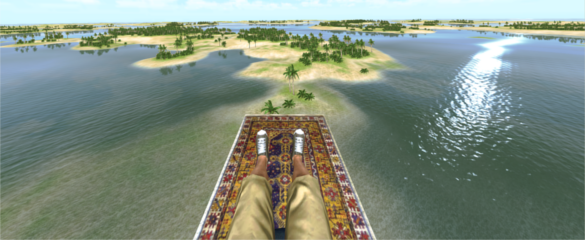Few people enjoy long-haul flights with their restricted space and close proximity to strangers. Add to that turbulence and an unsettled baby – yours or someone else’s – and it’s a pretty uncomfortable experience. The option of using virtual reality technology to fool ourselves into believing we are somewhere better would attract most of us.Now there is scientific evidence to prove it really does help. Researchers investigating whether virtual reality can help improve passengers’ experiences say people feel as if they are somewhere more spacious, and that time passed more quickly. Scientists tested the concept outside the lab for the first time in March 2014 on a long-haul flight with headsets used on smartphones.‘People have really embraced our ideas, and seeing the trends in technology, I believe that virtual reality in future planes is a real possibility,’ said Dr Mirabelle D’Cruz, coordinator of the EU-funded VR-Hyperspace project, which is developing virtual reality for use in aircraft.However, when Dr D’Cruz and her team began the three-year project in 2011, they thought assessing how virtual reality can improve comfort was a ‘crazy idea’. There were not many usable consumer headsets available at that time, but there has since been a boom in headset technology.“‘What we need now is for 3D content providers to take advantage of this fantastic opportunity.’Dr Mirabelle D’Cruz, VR-Hyperspace coordinatorAnd the speed of development of headset technology looks set to accelerate, especially now Facebook’s purchase of virtual reality headset maker Oculus announced in March this year shows it is worth investing in.As well as using the latest headset technology to test their ideas, partners on the EU-funded VR-Hyperspace project are also investigating whether incorporating virtual reality technology into the fabric of the aircraft itself can make us more comfortable.They have created lab-based mock-ups of the seating arrangements in an aeroplane. In these set-ups, television monitors are on the backs of seats and on the floor, and scenes are projected onto the aircraft walls.‘These large-scale displays will require a lot of work on the infrastructure of the plane, although it could be brought out before 2050,’ said Dr D’Cruz.See-through modeIn a mock-up produced by the Fraunhofer Institute for Industrial Engineering IAO in Stuttgart, Germany, the plane’s shell and the seats in front can be switched into a ‘see-though mode’.In this mode, changing aerial views of a beautiful landscape are displayed onto television monitors on the seats and floors and projected onto the cabin’s walls. These, combined with a head-tracking system, can alter passengers’ body awareness and give them a sense of flying around a landscape.The researchers used the cabin mock-ups to take volunteer passengers on a pretend flight, who then rated their levels of comfort in a questionnaire. The team focussed on two particularly uncomfortable situations: a crying baby and a restricted space in which the seat in front touches your knees.Early results indicate that space restrictions are much easier to overcome than a crying baby. ‘A crying baby on a beautiful tropical island is still a crying baby,’ said Dr D’Cruz.Previously virtual reality technology was only applied to aviation for pilot training and carrier design purposes. The researchers say their work has now paved the way for European companies to take advantage of this new market in in-flight entertainment.‘We’ve expanded the potential of virtual reality in the aviation sector in an area never considered before,’ said Dr D’Cruz. ‘What we need now is for 3D content providers to take advantage of this fantastic opportunity.’They emphasise that their work is about giving people choice: to be in the plane or somewhere else. Headsets of the future will not necessarily look like they do now, and in 20 or 30 years we could be wearing glasses to augment reality all the time.‘People are already choosing to opt out of the plane environment, immersing themselves on their tablet or smartphone with their headphones and wearables are not unusual,’ said Dr D’Cruz. ‘So our future vision is not inconceivable.’The team is working on a series of recommendations for carrier companies, indicating what needs to be done to roll out this technology.Virtual realityVirtual reality, or VR for short, is a technology that creates computer-simulated environments which can be explored by the person interacting with them. The environment usually includes 3D images and a form of motion capture that allows the computer to trace the movements and reactions of the viewer and adapt the simulation accordingly.The term ‘virtual reality’ goes back to Jaron Lanier, a pioneer in the field who coined the term in 1987. However, people began trying to create artificial environments much earlier, for example with 360-degree panorama murals in the 19thcentury. The first head-mounted display connected to a computer was created in the 1960s by computer scientist Ivan Sutherland.Initially, virtual reality remained largely outside the public eye and was used mainly in stationary settings like flight simulators. With the increasing performance of computers and the spread of wearable devices, however, the full potential of virtual reality is starting to emerge. The partnership announced in March this year between Facebook and Oculus VR, a company that develops virtual reality headsets for immersive gaming, may be a hint of what the future holds.
This article was originally published in Horizon, the EU Research and Innovation magazine.
Add to favorites:
Share:
Listing Description
Video
Documents
No documents available.
Ask KETMarket to make a contact
Connect with the Listing Owner!
💬 Please log in now to askKETMarket to make a contact. Not a member yet? Sign up for free and start connecting today!
Video
Related Funding and Finance Opportunities
Unlock Exclusive Funding Opportunities!
🔑 Get instant access to tailored funding opportunities that perfectly match your needs. This powerful feature is exclusively available to our premium members—helping you save time, stay ahead of the competition, and secure the right funding faster.
Upgrade to Premium now and never miss an important opportunity again! Already a premium member? Log in here to explore your matches.
Related Innovation Offers
Discover Tailored Innovation Offers!
🚀 Gain access to technology solutions that match your specific needs and interests—carefully selected to support your innovation goals. These offers are exclusively available to our premium members, helping you identify relevant technologies faster and start the right conversations with potential partners.
Upgrade to Premium now and explore your personalized technology matches today! Already a premium member? Log in here to view your tailored offers.
Related Knowledgeable Resources
Discover More with Premium: Related Knowledge Resources
🔒 You’re missing out on expert-curated knowledge specifically matched to this topic. As a Premium member, you gain exclusive access to in-depth articles, guides, and insights that help you make smarter decisions, faster.
Whether you’re preparing a funding proposal, researching a new market, or just need reliable information—our Premium knowledge matches save you hours of research and point you directly to what matters.
Upgrade to Premium now and instantly unlock relevant knowledge tailored to your needs! Already a member? Log in here to view your personalized content.

